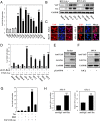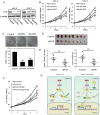HTLV-1 activates YAP via NF-κB/p65 to promote oncogenesis
- PMID: 35210364
- PMCID: PMC8892356
- DOI: 10.1073/pnas.2115316119
HTLV-1 activates YAP via NF-κB/p65 to promote oncogenesis
Abstract
Adult T-cell leukemia/lymphoma (ATL) is an aggressive malignancy caused by human T-cell leukemia virus type 1 (HTLV-1) infection. HTLV-1 exerts its oncogenic functions by interacting with signaling pathways involved in cell proliferation and transformation. Dysregulation of the Hippo/YAP pathway is associated with multiple cancers, including virus-induced malignancies. In the present study, we observe that expression of YAP, which is the key effector of Hippo signaling, is elevated in ATL cells by the action of the HTLV-1 Tax protein. YAP transcriptional activity is remarkably enhanced in HTLV-1-infected cells and ATL patients. In addition, Tax activates the YAP protein via a mechanism involving the NF-κB/p65 pathway. As a mechanism for this cross talk between the Hippo and NF-κB pathways, we found that p65 abrogates the interaction between YAP and LATS1, leading to suppression of YAP phosphorylation, inhibition of ubiquitination-dependent degradation of YAP, and YAP nuclear accumulation. Finally, knockdown of YAP suppresses the proliferation of ATL cells in vitro and tumor formation in ATL-engrafted mice. Taken together, our results suggest that p65-induced YAP activation is essential for ATL pathogenesis and implicate YAP as a potential therapeutic target for ATL treatment.
Keywords: ATL; HTLV-1; Tax; YAP; p65.
Copyright © 2022 the Author(s). Published by PNAS.
Conflict of interest statement
The authors declare no competing interest.
Figures





Similar articles
-
Suppression of Type I Interferon Production by Human T-Cell Leukemia Virus Type 1 Oncoprotein Tax through Inhibition of IRF3 Phosphorylation.J Virol. 2016 Mar 28;90(8):3902-3912. doi: 10.1128/JVI.00129-16. Print 2016 Apr. J Virol. 2016. PMID: 26819312 Free PMC article.
-
Ubiquitination and sumoylation of the HTLV-2 Tax-2B protein regulate its NF-κB activity: a comparative study with the HTLV-1 Tax-1 protein.Retrovirology. 2012 Dec 7;9:102. doi: 10.1186/1742-4690-9-102. Retrovirology. 2012. PMID: 23217160 Free PMC article.
-
Bcl-3 suppresses Tax-induced NF-κB activation through p65 nuclear translocation blockage in HTLV-1-infected cells.Int J Oncol. 2013 Jan;42(1):269-76. doi: 10.3892/ijo.2012.1685. Epub 2012 Nov 6. Int J Oncol. 2013. PMID: 23135533
-
Human T-cell lymphotropic virus: a model of NF-κB-associated tumorigenesis.Viruses. 2011 Jun;3(6):714-49. doi: 10.3390/v3060714. Viruses. 2011. PMID: 21743832 Free PMC article. Review.
-
HTLV-1 Infection and Adult T-Cell Leukemia/Lymphoma-A Tale of Two Proteins: Tax and HBZ.Viruses. 2016 Jun 16;8(6):161. doi: 10.3390/v8060161. Viruses. 2016. PMID: 27322308 Free PMC article. Review.
Cited by
-
PCBP1 interacts with the HTLV-1 Tax oncoprotein to potentiate NF-κB activation.Front Immunol. 2024 Apr 16;15:1375168. doi: 10.3389/fimmu.2024.1375168. eCollection 2024. Front Immunol. 2024. PMID: 38690287 Free PMC article.
-
An Update on the Metabolic Landscape of Oncogenic Viruses.Cancers (Basel). 2022 Nov 23;14(23):5742. doi: 10.3390/cancers14235742. Cancers (Basel). 2022. PMID: 36497226 Free PMC article. Review.
-
The Use of Intrinsic Disorder and Phosphorylation by Oncogenic Viral Proteins to Dysregulate the Host Cell Cycle Through Interaction with pRb.Viruses. 2025 Jun 10;17(6):835. doi: 10.3390/v17060835. Viruses. 2025. PMID: 40573426 Free PMC article. Review.
-
YAP-mediated trophoblast dysfunction: the common pathway underlying pregnancy complications.Cell Commun Signal. 2023 Dec 14;21(1):353. doi: 10.1186/s12964-023-01371-2. Cell Commun Signal. 2023. PMID: 38098027 Free PMC article. Review.
-
Changes in the expression profile of serum lncRNAs in pregnant women with high hepatitis B viral load during antiviral and non-antiviral treatment.BMC Pregnancy Childbirth. 2024 Oct 24;24(1):696. doi: 10.1186/s12884-024-06907-z. BMC Pregnancy Childbirth. 2024. PMID: 39449132 Free PMC article.
References
-
- Matsuoka M., Jeang K. T., Human T-cell leukaemia virus type 1 (HTLV-1) infectivity and cellular transformation. Nat. Rev. Cancer 7, 270–280 (2007). - PubMed
-
- Hall W. W., Fujii M., Deregulation of cell-signaling pathways in HTLV-1 infection. Oncogene 24, 5965–5975 (2005). - PubMed
-
- Nicot C., Harrod R. L., Ciminale V., Franchini G., Human T-cell leukemia/lymphoma virus type 1 nonstructural genes and their functions. Oncogene 24, 6026–6034 (2005). - PubMed
MeSH terms
Substances
LinkOut - more resources
Full Text Sources
Research Materials

